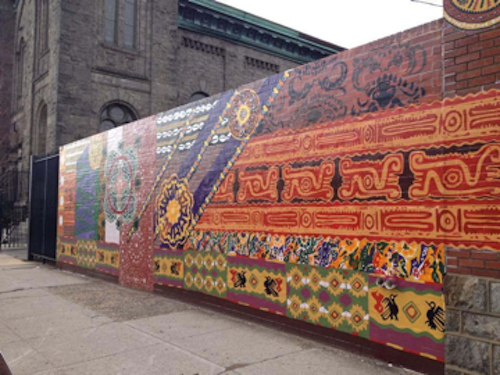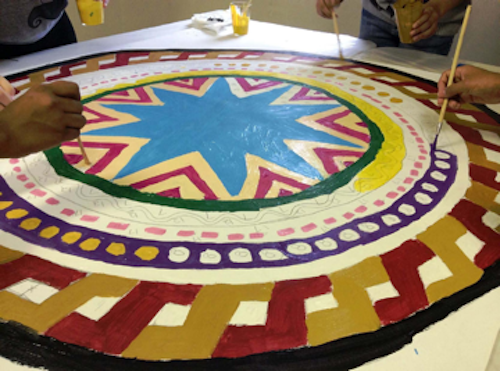Beautiful Walls: Reclaiming Urban Space through Mural Making
The deleterious effects of outward migration and disinvestment on American cities are well documented. The decline of the industrial economy left huge warehouses sitting empty and therefore susceptible to illicit use, fire, and possible collapse. Nearby housing that once sheltered low wage factory workers similarly sits vacant. Absentee landlords pretend not to see the broken window panes and sagging porches. As Wacquant (2010) argues, this abandonment then conveys a certain “social inferiority” about that community within the larger city construct.
The now stigmatized neighborhood could soon be forgotten when the built environment are perceived as a marginal outpost, a place tourists are advised to avoid after dark. However, in some cities, the affordable housing stock that remains and the proximity to service sector employment attracts immigrants and fosters conditions conducive to refugee resettlement. What emerges are complex, layered communities where people from different backgrounds and cultures come together in the same densely populated location. New residents rework how these previously depleted spaces are being used, experienced, owned, navigated, and understood.
During the nearly sixteen years I have lived and worked in inner city neighborhoods in New York, Delaware, and Philadelphia, I have seen communities reclaim these spaces by tackling the most visible things first. This includes clearing trash strewn vacant lots and creating murals on expansive exterior walls stained with marks of time. Philadelphia, in particular, has become a proving ground for the powerful place-making effects of murals, counting more than 3,500 beautiful walls across the city. This is due in part to the presence of the internationally recognized Mural Arts Program, a public/nonprofit collaborative which has developed a viable model that engages artists, grass roots nonprofits, established organizations, funders, and neighbors in co-creating murals that reclaim the streetscape.
Having coordinated and helped with many blight remediation projects from 2003-2012, it was a delight in 2013 to be able to experience the power of mural making more deeply when I spent a summer sabbatical as a studio assistant to Philadelphia muralist Betsy Casañas. I painted with volunteers, touched up mural panels in the evenings, and watched closely as Betsy’s brightly colored images were eventually installed on a drug rehabilitation center in a predominantly Latin@ community in North Philadelphia.
This opportunity reinforced my belief that community based organizations, churches, and schools are ideal agents to help reclaim marginalized urban spaces through murals. The discussion that follows shares specific examples of mural making that has: (1) united diverse communities in shared “ownership” of space; (2) illuminated the tenuous nature of the precariat (those individuals, families, and communities that face prolonged economic uncertainty); and (3) amplified the community’s voices.
Uniting Diverse Communities
In her research on the “community muralism movement,” Maureen O’Connell (2012) observes that in the process of mural making, “Various and often disparate members of civil society come together to create these wall-sized images that can run the length of a city block or rise many stories high” (p. xvii). This was certainly my experience with a community mural process in South Philadelphia where old and new residents collaborated to craft a visual representation of their richly diverse neighborhood. In the winter of 2013, as the founding director of a new community center serving immigrants and refugees, I heard from program constituents that they wanted to take back the blighted streetscape in front of the repurposed convent that now housed English classes, legal outreach, youth development programs, and more. Based on my previous mural work, I approached the Mural Arts Program and a city agency called PhillyRising to secure funding and installation expertise to help us.

Figure 1. 17th Street Mural on Aquinas Center courtyard wall
The months of collaborative community meetings and preparation culminated in a large public paint day where over 160 individuals painted for four hours under the direction of a professional artist. Children, youth, adults, and seniors from a range of cultural backgrounds participated. The resulting mural was designed to express the new center’s mission to “Build unity in diversity, support learning, and inspire thoughtful action” and did so through folklore traditions from Indonesia, Vietnam, Kenya, Guatemala, Mexico, and Italy, countries from which many local residents migrated.

Figure 2. Neighborhood teens work collaboratively on section of Fernon Street Mural
In the case of the Aquinas Center mural, the street level outcomes were immediate. Litter diminished and when it did pile up, neighbors and volunteer groups were more likely to arrange street clean ups. Graffiti became almost nonexistent on a wall that was once prime real estate for tagging. Over the course of the first year, records kept for grant reporting showed that the area around the mural was free of trash, graffiti, and illegal activity 45 out of 52 weeks, or roughly 85% of the time. Shared ownership was increased when a visiting teen volunteer from New Jersey inquired about extending the mural around the corner of the building to face a particularly blighted property adjacent. She replicated the entire year long process undertaken with the first mural and successfully engaged over 65 neighbors in the effort, including Asian and Latin@ immigrant teens as well as Black youth.
By repeating the process a second time, it became even more clear that the act of co-laboring increased community linkages among neighbors, which, as Wiseman (2002) suggests, are important to the overall investment that community members make in their own neighborhood.
Illuminate the Precariat
Catholic social activist Dorothy Day might well have been the first voice to capture the tenuous nature of the urban precariat in her book On Pilgrimage (1999), where she remarked, “And there is much wandering today, from job to job, from home to home. Most people want a settled place, but economic circumstances make it hard” (p. 97). In the ongoing participatory action research conducted at the Aquinas Center, and shared in Partnering with Immigrant Communities
(Campano, Ghiso, & Welch, 2016), it is evident that immigrant and refugee teens share adults’ concerns about access to education, stable housing, sufficient food, and employment that can pay the bills. For migrant families where the primary bread winner is undocumented, the threat of losing the current source of income is made worse by anxiety over workplace raids or a simple traffic stop that could result in deportation.
Susan Banki (2013), in her discussion on the precarity of refugee populations in resettlement locations, suggests that technology can be a valuable asset for mobilizing communities to act. I believe that murals are a similar catalyst. First, the visual images can raise awareness of pressing social concerns and second, can provoke dialogue that leads to change. Certainly, the increase in socially conscious murals in Philadelphia demonstrates the power of mural making to illuminate the state of the precariat, especially of those young people who are struggling to be seen, heard, and heeded. Murals depicting various dimensions of incarceration, immigration issues, discrimination, racism, religious liberty, pluralism, women’s rights, gambling addiction, and substance abuse have been installed in the last three years.
Amplify Disenfranchised Voices
Schools, houses of worship, community centers, and other engaged organizations that encourage mural making are critical agents in amplifying disenfranchised voices. For example, in another instance in South Philadelphia, one can see the important role that a school based program had in the life of a young Mexican teenager who became involved with the development and installation of the mural Aqui y Alla through a summer program at a local high school (Perez-Luna, 2012). The mural process allowed him to express his heartache over the separation from his grandmother who remains behind in Mexico. This particular mural, coordinated by Latin@ artist/activist Michelle Angela Ortiz, engaged the voices of many teens in similar situations, who feel torn between two countries. Because of the reality of current U.S. immigration laws, families like these will remain separated for the foreseeable future. Those without documentation cannot vote, obtain a driver’s license, move freely, or earn money in the formal economy. The balance between the passive and active parts of the mural making process and its visual nature can create a unique means to amplify voices without those voices being subject to ridicule.
Participating in mural making in a community context does not require one to have a formal relationship with the governing body in that location, such as a passport or driver’s license. If the resulting image is painted or installed on a community center or other institutional anchor, this tool for engagement does not require the participants to own their own property or to have the financial resources themselves to improve the streetscape. The message of the mural can therefore be expressed by people who are disenfranchised.
Conclusion
As mural making continues to be applied in community-based contexts, it is seen as an increasingly desirable public expression that leads to self-actualization and efficacy for both the individuals involved and the communities that engage with the physical space in which the mural is created. Teachers, school administrators, parents, and community leaders could encourage their local educational institutions and other civically minded organizations to lend their support as conveners and even canvases for these beautiful and provocative walls.
Banki, S. (2013). The paradoxical power of precarity: Refugees and homeland activism. Refugee Review: Social Movement, 1(1), 1–20.
Campano, G., Ghiso, M. P., & Welch, B.J. (2016). Partnering with immigrant communities: Literacy through action. New York, NY: Teachers College Press.
Day, D. (1999). On pilgrimage. Grand Rapids, MI: Eerdmans.
O’Connell, M. (2012). If these walls could talk: Community muralism and the beauty of justice. Collegeville, MN: Liturgical Press.
Perez-Luna, E. (September 17, 2012). “Young Mexican immigrants bridge ‘here’ and ‘there’ with mural.” Newsworks. Retrieved from http://www.newsworks.org/index.php/local/item/44228-young-mexican-immigr...
Mthethwa-Sommers, S. and Kisiara, O. (2015). Listening to students from refugee backgrounds: Lessons for education professionals. Perspectives on Urban Education, 12(1).
Wacquant, L. (2010). Urban desolation and symbolic denigration in the hyperghetto. Social Psychology Quarterly, 20(10), 1–5.
Wiseman, A. (2002). Neighborhood narratives: Learning about lives through conversations, writing, and photographs. Perspectives on Urban Education, 1(1).





